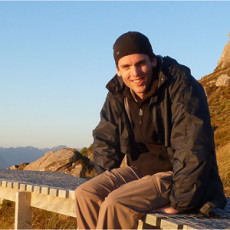Robert Saye, 2013 Luis W. Alvarez Fellow
September 22, 2013
As the 2013 Luis Alvarez Fellow in Computing Sciences, Robert Saye will be developing numerical methods and computational tools for studying a wide range of problems involving multiple evolving interfaces. These problems include modeling how grains develop in metallic and ceramic materials, studying the fluid dynamics of multi-cellular structures in complex geometries, and modeling the multi-scale dynamics of liquid foams. His methods will also have applications in multi-region shape optimization and image segmentation.
"My father was a computer programmer, and when I was young, I was amazed with how much control he had over what his software did. This sparked my interest in computer programming, and soon I was developing my own custom software," says Saye, who is originally from Canberra, Australia. "I then discovered that I really enjoyed combining this with my skills in mathematics, in order to solve puzzles that are too complex to do by hand. A year later I was preparing my application to study applied mathematics at university."
As an undergraduate at the Australian National University in Canberra, Saye was encouraged to create and design his own research projects. One of these projects involved modeling how a droplet of water splashes into a pool.
"This work needed a wide range of algorithms, from numerical methods that model the fluid mechanics and track the evolving interface, to custom-made methods for visualizing the flow," says Saye. "Through these research projects, I discovered that applied math is not just about theory and numerical methods, but also about combining complementary ideas and developing an 'instinct' for what will work. This mixture of theory and creativity leads to some very rewarding results, especially when the developed methods have a wide range of interdisciplinary applications."
As a graduate student at the University of California, Berkeley, Saye worked on problems involving multiple moving interfaces, such as foams of soap bubbles. "These interfaces often meet at junctions in complex configurations, so accurately determining how they evolve requires careful treatment," he says. As part of this work, Saye collaborated with Berkeley Lab Mathematician James Sethian to develop the "Voronoi Implicit Interface Method (VIIM)." The work was recently published in the Proceedings of the National Academy of Sciences (PNAS), where it received the Cozzarelli Prize.
"After being in Berkeley for five years, I've come to really enjoy the wide range of applied math that goes on here. I was fortunate to spend much of my time at Berkeley Lab," says Saye. "The lab has a very stimulating, yet relaxing, environment that I truly enjoy, with many smart and friendly people to interact with. In continuing my research, it was a natural choice to stay here at the lab, and I am lucky to receive the Alvarez Fellowship so that I can do this with maximum flexibility."
Saye will begin his postdoctoral fellowship in the Computational Research Division's Mathematics Group in September 2013. In his spare time, Saye enjoys hiking, playing tennis, and landscape photography.
About Computing Sciences at Berkeley Lab
High performance computing plays a critical role in scientific discovery. Researchers increasingly rely on advances in computer science, mathematics, computational science, data science, and large-scale computing and networking to increase our understanding of ourselves, our planet, and our universe. Berkeley Lab’s Computing Sciences Area researches, develops, and deploys new foundations, tools, and technologies to meet these needs and to advance research across a broad range of scientific disciplines.







 Instagram
Instagram YouTube
YouTube